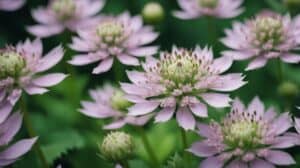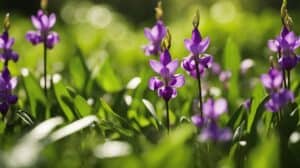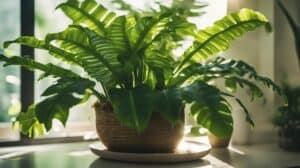The Calathea lancifolia, commonly known as the Rattlesnake Plant, is a popular houseplant among the plant enthusiasts.
With its distinctive foliage and manageable size, it makes for a great addition to any indoor garden.
However, like any other plant, it requires proper care and attention to thrive.

In this article, we will discuss essential tips for the aspiring Calathea lancifolia grower to help them maintain a healthy and happy plant.
From watering and fertilizing to lighting and humidity, we will cover all the necessary aspects of Rattlesnake Plant care.
Whether you’re a beginner or an experienced plant parent, these tips will help you grow a stunning Calathea lancifolia.
So, let’s dive in and learn how to take care of this beautiful plant!
Understanding Rattlesnake Plant Basics
Species Overview
The Rattlesnake Plant, scientifically known as Calathea lancifolia, is a popular houseplant that is native to the tropical regions of Brazil.
It is known for its striking foliage, which features dark green leaves with light green markings that resemble the pattern of a rattlesnake’s skin.
This plant is a member of the Marantaceae family, which includes other popular houseplants like the Prayer Plant and the Stromanthe.
Like other members of this family, the Rattlesnake Plant is known for its ability to fold its leaves up at night, then unfurl them again in the morning.
Native Habitat
The Rattlesnake Plant is native to the tropical rainforests of Brazil, where it grows in the understory beneath taller trees.
In its natural habitat, it receives filtered light and high humidity, which are important factors to consider when caring for this plant indoors.
This plant thrives in warm, humid environments and prefers to be kept in bright, indirect light.
It is also important to keep the soil consistently moist, but not waterlogged, as overwatering can lead to root rot.
Overall, the Rattlesnake Plant is a beautiful and unique addition to any indoor plant collection.
With proper care and attention, it can thrive and provide years of enjoyment for the aspiring Calathea lancifolia grower.
Essential Care Guidelines

Lighting Requirements
The Rattlesnake Plant, also known as Calathea lancifolia, requires bright, indirect light to thrive.
It is best to place the plant near a window that receives filtered sunlight, or in a well-lit room.
Direct sunlight can damage the leaves, so it is important to avoid placing the plant in direct sunlight.
Watering Techniques
The Rattlesnake Plant prefers to be kept moist but not waterlogged. It is important to water the plant when the top inch of soil is dry.
When watering, make sure to water the soil evenly and thoroughly.
Overwatering can lead to root rot and other issues, so it is important to avoid letting the plant sit in standing water.
Soil and Potting Mix
The Rattlesnake Plant prefers well-draining soil that is rich in organic matter.
A mix of peat moss, perlite, and vermiculite is a good choice for potting this plant.
It is important to repot the plant every 1-2 years to ensure that it has enough room to grow.
Temperature and Humidity Control
The Rattlesnake Plant prefers temperatures between 65-80°F (18-27°C) and high humidity levels.
It is important to avoid placing the plant near drafts or in areas with temperature fluctuations.
To increase humidity levels, it is recommended to place a tray of water near the plant or to mist the leaves regularly.
By following these essential care guidelines, aspiring Calathea lancifolia growers can ensure that their Rattlesnake Plant thrives and remains healthy.
Advanced Care Tips

Fertilization Schedule
Once your Rattlesnake Plant has reached maturity, it’s important to fertilize it regularly to ensure it remains healthy and vibrant.
During the growing season, which typically runs from early spring through late summer, apply a balanced, water-soluble fertilizer every two weeks.
During the fall and winter months, cut back to once a month. Be sure to dilute the fertilizer to half strength to avoid burning the plant’s roots.
Pruning and Maintenance
To keep your Rattlesnake Plant looking its best, it’s important to prune it regularly.
Remove any yellow or brown leaves as soon as you notice them, as they can attract pests and diseases.
You can also pinch back the tips of the plant to encourage it to grow bushier and fuller.
Additionally, be sure to keep the plant’s soil moist but not waterlogged, and mist the leaves regularly to increase humidity.
Propagation Methods
If you want to propagate your Rattlesnake Plant, the best method is by division.
Wait until the plant has become too large for its pot, then carefully remove it from the soil and separate it into smaller sections.
Be sure to include both roots and leaves in each section.
Plant each section in its own pot with fresh soil, and keep it well-watered until it becomes established.
Remember, the key to successful Rattlesnake Plant care is to provide it with the right growing conditions and regular maintenance.
With a little bit of effort, you can enjoy the beauty of this stunning plant for years to come.
Frequently Asked Questions

What are the common issues with rattlesnake plants and how can I address them?
Rattlesnake plants are susceptible to some common issues such as spider mites, mealybugs, and leaf spot disease.
To address these issues, it is recommended to regularly inspect the plant and remove any affected leaves.
It is also important to provide adequate humidity and avoid overwatering the plant.
What are the benefits of having a rattlesnake plant in my home?
Rattlesnake plants not only add a touch of natural beauty to your home, but they also help purify the air by removing toxins.
They are also relatively low maintenance and can thrive in low light conditions.
How often should I fertilize my rattlesnake plant, and what type of fertilizer is best?
It is recommended to fertilize your rattlesnake plant every 2-3 months during the growing season with a balanced, water-soluble fertilizer.
Avoid over-fertilizing as this can lead to burnt leaves.
Can you explain the steps for propagating a rattlesnake plant?
To propagate a rattlesnake plant, you can divide the plant during repotting or take stem cuttings and root them in water or a well-draining soil mix.
It is important to keep the cutting moist and warm until it develops roots and establishes itself.
Why do the tips of my rattlesnake plant turn brown, and how can I prevent it?
The tips of rattlesnake plant leaves can turn brown due to underwatering, low humidity, or exposure to direct sunlight.
To prevent this, make sure to water the plant regularly, provide adequate humidity, and place it in a location with indirect sunlight.
Is it true that rattlesnake plants prefer to be root-bound, and how does this affect their care?
Rattlesnake plants can tolerate being root-bound to some extent, but it is important to repot them every 1-2 years to provide fresh soil and nutrients.
If the plant becomes too root-bound, it can lead to stunted growth and a decline in overall health.














